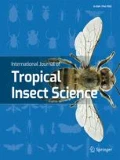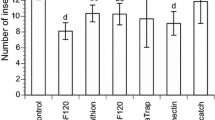Abstract
Four types of trap, yellow water, yellow sticky board, bottle with 20% protein hydrolysate, and funnel with 10% casein hydrolysate, were field-tested to control Liriomyza huidobrensis (Blanchard) in the coastal region of Peru. The yellow sticky boards were the most effective in trap capture with a mean of 1193.92 L. huidobrensis per week. The male:female capture ratio was 16:1.
Five parasitoid species, Halticopiera patellana, Chrysocharis phytomyzae, Chrysocharis sp., Diglyphus sp. and Opius sp., were also trapped. A significant negative correlation (r = —0.607 at P < 0.05) was observed for female leafminer capture vs temperature. Wind velocity was positively correlated with parasitoid capture (r = 0.509 at P < 0.05). The population of adult L. huidobrensis was significantly lower (P < 0.05) in plots with yellow sticky boards. Yields in plots with yellow sticky boards and those treated with insecticides were similar and significantly higher (36%) than check plots..
Résumé
Quatre types de pièges ont été testés en champ afin de contrôler le Liriomyza huidobrensis (Blanchard) dans la région côtiére du Pérou: le piége jaune a eau, le piége jaune gluant, le flacon avec 20% de protéine hydrolysée et l’entonnoir avec 10% de caséine hydrolysée. Le plus efficace s’est avéré etre le piège jaune gluant avec une moyenne de 1193.92 L. huidobrensis par semaine. La proportion mâle/femelle etait de 16:1.
Cinq especes parasitaires ont également été capturees: Halticoptera patellana, Chrysocharis phytomyzae, Chrysocharis sp., Diglyphus sp. et Opius sp.. On a observé une correlation négative (r = —0,607 avec P < 0.05) entre la capture des insectes mineurs de feuilles femelles et la température, et une corrélation positive (r = 0.509 avec P < 0.05) entre la vitesse du vent et la capture des parasites. La population de L. huidobrensis adulte était nettement plus faible (P < 0.05) dans des parcelles nanties de piéges jaunes gluants. Les rendements enregistrés dans les parcelles nanties de pieges jaunes gluants ou traitées aux insecticides etaient similaires et nettement plus éléves (28.57%) que dans les parcelles témoins.
Similar content being viewed by others
References
Anonymous (1984) Annual Report. International Potato Center (CIP), Lima, Peru.
Alverson D. R. and Gorsuch C. S. (1982) Evaluation of chrysanthemum cultivars and insecticides for control of damage by leafminer, Liriomyza trifolii (Diptera: Agromyzidae). J. econ Ent. 75, 888–891.
Bauerle B. and Lindquist R. K., (1983) Tapes, biological controls thwart greenhouse pests. American Vegetable Grower and Greenhouse Grower 31, 42.
Cisneros F. H. (1984) The need for integrated pest management in developing countries. In Report of the XXII Planning Conference on Integrated Pest Management, CIP, Lima, Peru. pp. 19–30.
Chandler L. D. (1981) Evaluation of different shapes and color intensities of yellow traps for use in population monitoring of dipterous leafminers. S. West Ent 6, 23–27.
Ferro D. N. and G. J. Suchak (1980) Assessment of visual traps for monitoring the asparagus miner Ophiomyia simplex, Agromyzidae: Diptera. Ent. exp. appl. 28, 177–182.
Lindquist R. K. (1980) The leafminer problem. Ohio Florists Ass. Bull. 614.
McPhail M. (1939) Protein lures for fruit flies. J. Econ. Ent. 32, 758–761.
Parrella M. P. and Keil C. B. (1984) Insect pest management: The lesson of Liriomyza, Bull Ent. Soc. Am. 2, 22–25.
Palacios M. and Cisneros F. H. (1980) Biologia y com-portamiento de la mosca minadora Liriomyza hu-idobrensis (Blanchard). In XXIII Con. Nac. de Entomologia, Huacho, Peru (abstract).
Raman K. V. (1984a) Evaluation of a synthetic sex pheromone funnel trap for potato tuberworm moths (Lepioptera:Gelechiidae). Environ. Ent. 13, 61–64.
Raman K. V. (1984b) Progress in pheromone utilization and other novel control practices. In Report of the XXII Planning Conference on Integrated Pest Management, International Potato Center, Lima, Peru. pp. 217–233.
Spencer K. A. (1973) Agromyzidae of economic importance. Ser. Ent. Hague 9, 1–418.
Tyron E. H., Poe S. L. and Cromroy H. L. (1980) Dispersal of vegetable leafminer onto a transplanted production range. Fla. Ent. 63, 292–296.
Author information
Authors and Affiliations
Rights and permissions
About this article
Cite this article
Chavez, G.L., Raman, K.V. Evaluation of Trapping and Trap Types to Reduce Damage to Potatoes by the Leafminer, Liriomyza Huidobrensis (Diptera, Agromyzidae). Int J Trop Insect Sci 8, 369–372 (1987). https://doi.org/10.1017/S1742758400005403
Received:
Revised:
Published:
Issue Date:
DOI: https://doi.org/10.1017/S1742758400005403




